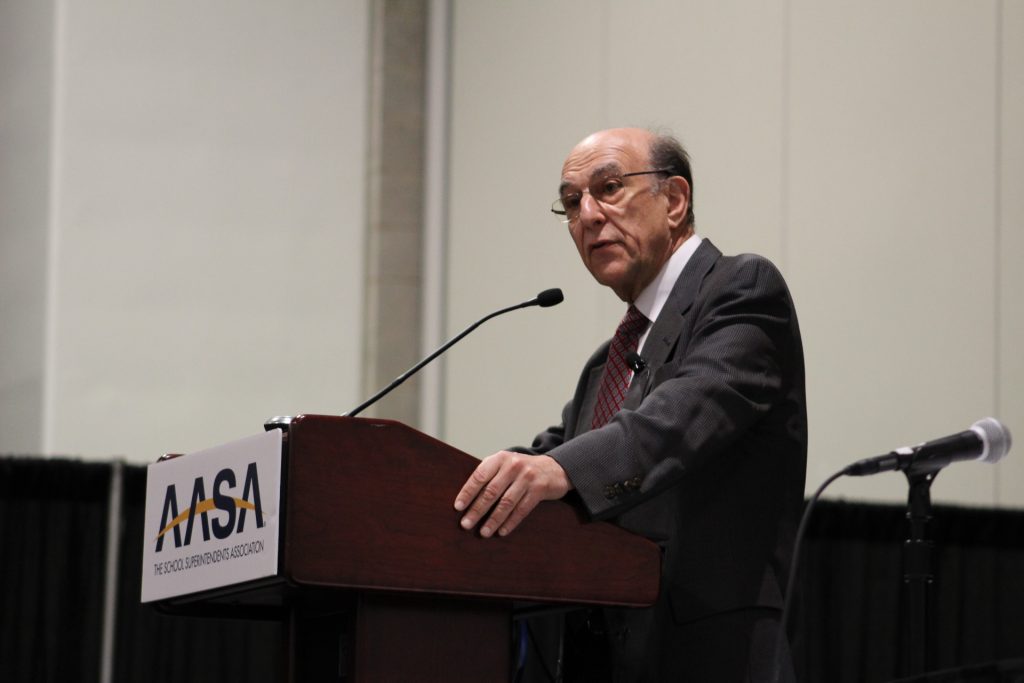Richard Rothstein, in his Thought Leader session Thursday at the AASA national conference, described what he see as the primary cause behind the segregation that continues today in public education.
A public policy researcher in Berkeley, Calif., affiliated with Economic Policy Institute, Rothstein spoke in the Knowledge Exchange Theatre at Nashville’s Music City Center.
The author of The Color of Law: A Forgotten History of How Our Government Segregated America, Rothstein argued that residential segregation is a major contributor to segregation in K-12 school systems. According to Rothstein, residential segregation was openly designed by racially conscious government policies put in place decades ago.
“Schools are more segregated now in this country than at any time in the last 50 years,” he said. “We have more schools concentrating children with disadvantages now than any previous time since the Brown v. Board of Education decision.”
During his presentation, Rothstein explained that segregation practices exist at every level of government. Government policies and criminal prosecutions have prevented African Americans from moving into white neighborhoods. The federal government’s public housing program along with the practices of the Federal Housing Administration involving suburbanization have maintained racial segregation, leading to public schools with homogeneous enrollment.
“The residential boundaries of every residential neighborhood in this country were determined by explicit federal policy,” Rothstein said. “Federal, state and local policy is designed to implement residential segregation.”
Rothstein believes the nation has refused to deal with residential segregation by adopting the myths that it happened by accident, that it only came about because of personal prejudice and discrimination and that the segregation was not actually imposed and designed. Because of these myths, political leaders believe the fix to this discrimination lies in personal choices, not through government intervention.
“If we understood this history, we would understand that not only is residential segregation immoral and harmful, but it’s unconstitutional and we have an obligation as a country — if we want to be a constitutional democracy to follow policies that are as aggressive to desegregation as the policies we followed to segregate,” Rothstein explained.
One key policy Rothstein discussed was the American Housing Act of 1949, which was a sweeping expansion of public housing under President Truman. Current views of public housing as being subsidized for poor people do not reflect how the program started.
“Shortly after these projects were built, a development occurred all over the country,” Rothstein said. “It was identical everywhere. There were long waiting lists for the African American projects and large numbers of vacancies in the white projects. After a while, the situation became so conspicuously untenable, of some projects having long waiting lists and other projects having large numbers of vacancies that the government had to open up all the projects to African Americans, even the white projects.”
Eventually, the projects became primarily all African American while the government pushed for white families to move into the suburbs, which were often more affordable than housing in the projects, he said. The effects of the program are still felt today.
Rothstein believes continued residential segregation leaves schools largely segregated because these schools are located in segregated communities.
Throughout his presentation, Rothstein expressed the importance of ridding our society of residential segregation if we want to rid ourselves of educational segregation, and he wanted everyone to leave with one key takeaway: “We have a constitutional obligation to enact aggressive policies for neighborhood desegregation comparable to the policies that we enacted to abolish all other forms of segregation.”
(Steve Barnum, a senior at Middle Tennessee State University, is an intern with Conference Daily Online.)

